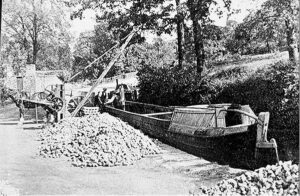This short branch was built in 1802 by Peter Nightingale, great uncle of the famous Florence.
At the junction with the main line, the iconic Aqueduct Cottage dominates the scene and at the time of writing was in the process of restoration as an interpretation centre.
Beside the cottage is a stone-built narrows, with recesses for stop gates clearly visible. There was a small wooden swing bridge over these narrows giving access to the cottage, but this has been replaced by the concrete stank. From here walk along the left bank of the branch, which runs on a dramatically steep embankment.
At first the towpath traverses a narrow strip of land between the canal and the River Derwent. The channel, which is sometimes in water, soon ends abruptly at the site of what was once an iron trough aqueduct over the railway. This was in a very similar situation to the existing railway aqueduct on the main line of the canal at the opposite end of Lea Wood railway tunnel, but here the aqueduct has been replaced by a footbridge over the railway.
Beyond, the canal bed is intact but usually dry and the towpath makes a pleasant walk to the wharf at the terminus. At the wharf entrance, there is a small stone building on the towpath. Note that this incorporates a stone gatepost with the familiar grooves worn by horse-boat towlines. There would have been a gate across the towpath here to keep the wharf secure. The wharfinger’s stone cottage has been extended to make an attractive private residence. On the edge of the wharf, signs of the iron turntable for the crane can still be discerned.
The branch terminates shortly beyond but was originally twice as long, reaching Lea Bridge. Following a dispute over water supply, it was truncated and the wharf re-located here. From this point you can retrace your steps or turn left on the public footpath, left again on the road in Lea Bridge from where another left turn brings you to High Peak Junction Car Park and thus across the river Derwent to the canal.

